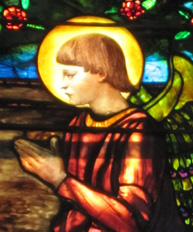
|
||||||||
| NEWARK: Church Mulling $2 Million Offer for Tiffany Windows | |||||||
|
The vestry of St. Paul's Episcopal Church in Paterson, New Jersey, is scheduled to vote March 31 on whether to accept an anonymous collector's $2 million offer to buy 13 of its stained-glass windows. The collector, who first made the offer about a year ago, also would pay for removal, restoration and window-replacement costs, said St. Paul's rector, the Rev. David Wolf. Famous artisan Louis Tiffany created 12 of the windows at the Diocese of Newark church; his contemporary, artist John La Farge, designed the other. The potential buyer hopes to exhibit the windows this fall and asked the church to decide no later than April to provide time to prepare them to show. Before considering a decision, St. Paul's vestry obtained appraisals of the windows' market value and their restoration costs if unsold, and researched legal issues including whether the windows were restricted gifts, said Warden Rosie Grant, a former vestry member. Christie's estimated the windows' auction value between $1,260,000 and $1,930,000, while an independent appraiser valued them at $2,515,000, not including removal or restoration, and estimated $1,900,000 to $2,300,000 as a fair price, according to the church. If the windows aren't sold, two appraisers estimated the cost of fully restoring and refurbishing them at $230,000 and $520,000, not including recommended protective bulletproof glazing. If sold, the windows' proceeds would go into the parish's endowment. "This was an unsolicited offer," Grant stressed. "We were not considering selling our windows to fund mission and ministry. We still have a vibrant mission and ministry, and I would hope that we still would." Stewardship of the buildings, however, is critical to the mission of St. Paul's, which runs an after-school program, provides meeting space for various groups and started a community development corporation that offers programs including a food pantry and men's shelter. "They're all embedded in the structure," Wolf said. "This place is open 24-7, 365 days a year. There's always a presence here. Forty to 50 men live here. … This building is constantly in use." Other "companion congregations" provide volunteers and funding to support the programs, Wolf said. "Part of our outreach is the offering of our physical plant to make this happen." The "wear and tear," he said, is "way more than [in] your average parish, and way more than what a regular operating budget really can handle." The church is growing – average Sunday attendance exceeded 160 during Lent – but total pledge income has declined because of the socio-economic status of the inner-city church's members, Wolf said. Located in the nation's first planned industrial city, St. Paul's once was the country's 10th largest Episcopal congregation. "It was the wealthy industrialists who owned the plants, ran the plants, that were among the primary membership of this parish," Wolf said. But the textile mills that earned Paterson the nickname "Silk City" are gone. "Paterson itself has declined," Wolf said, calling it "rich in diversity and multicultural opportunities, but poor economically." Another once-prosperous inner-city parish in the state, St. John's Episcopal Church in Elizabeth, Diocese of New Jersey, kept its doors open last summer by selling three of its Tiffany memorial windows and would like to sell two more. An anesthesiologist opening a stained-glass museum in West Texas paid $500,000 for them, said the Rev. Joe Parrish, rector. "In the ‘50s, we were the richest church in the New Jersey diocese," he said. But demographics changed dramatically, and the church's ministries now include feeding as many as 120 people on Sundays, sheltering the homeless on winter nights and distributing clothing to the needy. The congregation, with average Sunday attendance of 104, worships in a new sanctuary in the parish hall rather than spend $1,000 a week to heat the church, Parrish said. The church's endowment had dropped to $20,000 before the window sale. "It kept us alive," Parrish said. Not everyone embraced the sale, but only one person left the church over the issue, he said. At St. Paul's, no one has left or threatened to leave over the potential window sale, Grant said. Parishioners first were told about the possible sale by letter in November. Informal discussions and two formal listening sessions followed. The discussions all "have remained respectful," Grant said. "There are differing opinions, but people have continued to honor each other. … I don't remember who said it first, but it's been a great opportunity to walk a Lenten journey together." "I think we have a great process outlined," she said. "It's not by any means an easy process, and neither is it going to be an easy decision." The vestry plans to vote March 31, Grant said. "We'll have some discussion first, so I can't predict what will happen, but that's what's in the plan. … We're praying to be led by the Spirit." |
|
||||||
 |
Last
Updated
April 3, 2010


